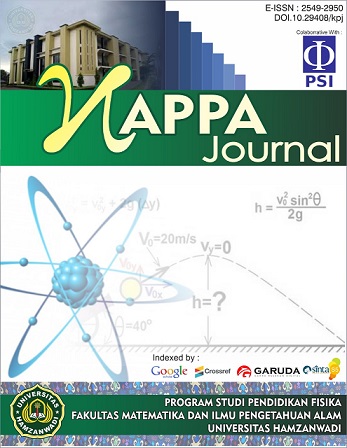Pengembangan Multimedia Interaktif Berbasis PBL pada Materi Gerak Parabola untuk Meningkatkan Hasil Belajar Peserta Didik
DOI:
https://doi.org/10.29408/kpj.v5i2.4394Abstract
The process of learning physics at various levels of education is still faced with several difficulties, especially the use of interactive multimedia which is still lacking so that educators are required to innovate to develop interactive multimedia to increase interest in learning and student learning outcomes. This research is a development research that aims to produce interactive multimedia based on problem based learning that is valid, effective, and practical to improve student learning outcomes on parabolic motion material. The research development model used in this study is a 4D (four D) model consisting of define, design, develop and disseminate. The instruments in this development research consist of interactive multimedia, syllabus, lesson plans, LKPD, test instruments. The data collection techniques used in this study were expert validation, limited trials and student responses. The results showed that interactive multimedia had an average score of 3.12 with a very good category, the syllabus had a score of 78.08% with a very valid category, lesson plans had a score of 73.66% with a fairly valid category, LKPD had a score of 75.50% with a very valid category and the test instrument has a score of 77.60% with a very valid category. Interactive multimedia based on problem based learning is effectively used with an average score of 3.04 with a very good category and is effectively used because there is an increase in learning outcomes with an N-gain value of 0.49 having a medium category. Interactive multimedia based on problem based learning on parabolic motion material is valid, practical, and effectively used in learning so that it is suitable for use in the learning process and proven to improve students' cognitive learning outcomes
References
Awwaliyah, R. (2018). Pendidikan Islam Dalam Sistem Pendidikan Nasional. Jurnal Ilmiah Didaktika,(19)(1), 34-49
Celik, P., Onder, F., & Silay, I. (2011). The Effects Of Problem-Based Learning On The Students’ Success In Hysics Course. Procedia - Social and Behavioral Sciences, 28, 656–660.
Hastuti, A.,Sahidu, H. dan Gunawan. 2016. Pengaruh Model PBL Berbantuan Media Virtual Tehadap Kemampuan Pemecahan Masalah Fisika. Jurnal Pendidikan Fisika dan Teknologi, 2(3), 129-135.
Istiqamah, (2019). Validitas Perangkat Pembelajaran Konsep Pencemaran Lingkungan Untuk Meningkatkan Keterampilan Komunikasi Sains Siswa SMA di Banjarmasin. Jurnal Ilmiah Kependidikan. 8(2), 117-124.
Khamzawi, S., & Wiyono, K. (2015). Pengembangan Multimedia Interaktif Berbasis Model Pembelajaran Problem Based Leaning Pada Mata Pelajaran Fisika Pokok Bahasan Fuida Dinamis Untuk SMA Kelas XI. Jurnal Inovasi Dan Pembelajaran Fisika, 2(1), 100–108.
Rafmana, H., Chotimah, U., & Alfiandra. (2018). Pengembangan Multimedia Interaktif Berbasis Articulate Storyline Untuk Meningkatkan Motivasi Sma Srijaya Negara Palembang. Jurnal Bhinneka Tunggal Ika, 5(1), 52–65.
Rahmadani, R., & Taufina, T. (2020). Pengembangan Multimedia Interaktif Berbasis Model Problem Based Learning (PBL) Bagi Siswa Sekolah Dasar. Jurnal Basicedu, 4(4), 938-946.
Rahmani, R., Abbas, M., & Alahyarizadeh, G. (2013). The Effects Of Peer Scaffolding In Problem-Based Gaming On The Frequency Of Double-Loop Learning And Performance In Integrated Science Process Skills. Procedia - Social and Behavioral Sciences, 93, 1994–1999
Rahmawati & Dewi .(2019). Penggunaan Multimedia Interaktif (MMI) Sebagai Media Pembelajaran Dalam Meningkatkan Prestasi Belajar Fisika. Jurnal Pendidikan Fisika dan Teknologi, 5(1), 51-58.
Ridwan, Y. H., Zuhdi, M., Kosim, K., & Sahidu, H. (2021). Pengembangan Media Pembelajaran Interaktif Berbasis Model Problem Based Learning Untuk Meningkatkan Kemampuan Berpikir Kreatif Fisika Peserta Didik. ORBITA: Jurnal Kajian, Inovasi Dan Aplikasi Pendidikan Fisika, 7(1), 103-108.
Selçuk, G. S., & Çalişkan, S. (2010). A Small-Scale Study Comparing The Impacts Of Problem-Based Learning And Traditional Methods On Student Satisfaction In The Introductory Physics Course. Procedia - Social and Behavioral Sciences, 2(2), 809–813
Skills, S. (2017). Pengembangan Multimedia Interaktif Bervisi SETS sebagai Alat Bantu Model Problem Based Learning (PBL) dalam Pembelajaran IPA di SMP untuk Meningkatkan Kemampuan Berpikir Kritis dan Keterampilan Sosial Peserta Didik. Pancasakti Science Education Journal. 2(2), 125–137.
Sugiyono, (2015). Metode Penelitian Tindakan Komprenhensif. Yogyakarta: Alfabeta
Sujono, H.D. (2017). Multimedia Pembelajaran interaktif. Yogyakarta:UNY press
Sulaiman, F. 2010. Students’ Perceptions Of Implementing Problem-Based Learning In A Physics Course. Procedia - Social and Behavioral Sciences, 7(2), 355–362.
Usman & Basyiruddin. (2002). Media Pembelajaran. Jakarta: Ciputat Press
Wiyono, K. (2015). Pengembangan Multimedia Interaktif Berbasis Model Pembelajaran Problem Based Learning Pada Mata Pelajaran Fisika Pokok Bahasan Fluida Dinamis Untuk Sma Kelas XI. Jurnal Inovasi dan Pembelajaran Fisika. 2(1), 100–108.
Syahidi, K., Hizbi, T., Hidayanti, A., Ditinjau, B., Kemampuan, D., & Kritis, B. (2020). The Effect of PBL Model Based Local Wisdom Towards S tudent ’ s Learning Achievements on Critical Thinking Skills Pengaruh Model PBL Berbasis Kearifan Lokal Terhadap Prestasi. Kasuari : Physics Education Journal ( KPEJ ) Universitas Papua, 3(1), 61–68.
Yunita, N., Zahara, L., & Syahidi, K. (2020). Pengaruh Model Problem Based Learning (PBL) Melalui Lesson Study Terhadap Kemampuan Berpikir Kritis Siswa. Kappa Journal, 4(2), 233–239. https://doi.org/10.29408/kpj.v4i2.2756



